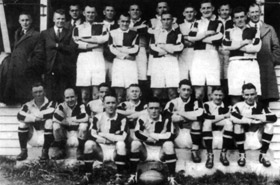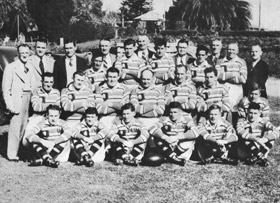The Harlequin Football Club was born in 1869 in London. The members had first played in 1866 - only a few years after rugby and soccer had begun to go their separate ways - as Hampstead FC. But their only tie with Hampstead was that they had found a convenient field there, and so in 1869 the members decided on a change of name.
The one problem was the handsome monogram, H.F.C. with the motto Nunquam Dormio ('I never sleep') which it was reluctant to discard. The members therefore thumbed through the H section of a dictionary until their eyes lit on Harlequin. They liked it, and at once decided on a bizarre mixture of colours "which only familiarity has made tolerable to the eyes", according to some of the British media.

The club colours, light blue, magenta, chocolate and french grey, green, black with white shorts have lived on. It was as the Harlequins that the club became a founder member of the Rugby Football Union two years later. Soon Harlequin players had made their way into the international scene and the club scene was rosy.
But a turn in fortunes just before the old century faded out had the club stalwarts worried. It was only a collection of £66.9s.6d at a meeting in 1900 that saved the club from liquidation. Another event occurred in that year which was to change the course of Harlequin and, indeed, English history.
When the 'A' side was playing a 'missionary' game at Rugby School, a promising boy was noticed in the opposing team and he was invited to join the club. His name was A.D.Stoop. He did not accept at once, for he had also been approached by Blackheath. However, Blackheath officials lost their patience and withdrew their invitation, so he became a 'Quin'. He first played for the club in 1902 - against his own University, Oxford, when he was in his freshman year. His was the only try of the match.
It was not until the 1905-06 season, however, after he had came down from Oxford, that the Stoop era properly began. He was made captain and remained in that role for eight years until the First World War broke out.
An autocrat with complete conviction of what was wrong with rugby, and how it could be put right, Stoop exercised an authority almost unsurpassed in the game. The players (after some early misgivings) accepted it. They were exhilarated by the successes they had. Players queued up to be invited into the club. The Harlequins had arrived.
Gallagher's New Zealand tourists of 1905 had demonstrated a similar approach. The aim was prolonged, fluid movement, the giving and taking of direction, the use of carefully rehearsed maneuvers. Stoop could list without hesitation 16 distinctly different ways in which halves and centres could combine in attack. The reverse pass, the cut out pass, the cross kick….Stoop showed them all in his play.
His international appearances were full of excitement. England selected most of the Harlequin backs as they knew Stoop's style. Stoop's legend lived on long after he ceased to play. Another outstanding Harlequin, Wavell Wakefield (subsequently Lord Wakefield of Kendal) told this story of a Harlequin tour involving Stoop.
"On Easter Sunday we were presented with Easter eggs. Before long Stoop, using the eggs as a ball, was showing the small boys how to fall correctly. When the youngster had achieved what Stoop wanted, the Easter egg was the prize".

Because of Stoop's influence on the game, it was seen fitting, therefore, that when the Rugby Union's new ground at Twickenham was opened in 1910, the Harlequins should have been allotted the tenancy.
Since then Harlequins have opened a new ground and clubhouse near Twickenham, but the first XV still plays at headquarters. Fittingly the new premises were after Adrian Stoop.
The Harlequin Ruby Football Club (Inc.) Hamilton, New Zealand, was formed in the State Fire Office, Hamilton, on June 15, 1938. The first president was Mr. A.St.C. Belcher and Mr.A.J.Denz the first secretary.
Returning from the 1935 All Blacks tour to Great Britain, Aucklander H.F. McLean brought with him a burning desire to form a club in Auckland with the same ideals as the Barbarian club of England. Soon after the team returned home, McLean gathered about him a band of young and old rugby men and in 1937 led forth the first Barbarians team to Thames.
In the Waikato at the time a group of rugby players and administrators quickly realized the worth of McLean's plan and they set about forming a similar club. R.A. (Jerry) Wilcox reports those present at the June 15 meeting were: A.StC. Belcher, S.Thomas, J.Bain, G.Muir, A.Robson, S.Egan, J.Tuck and L. and J. Denz.

The proposition, put by Belcher, seconded by Tuck, that a Club should be formed, was duly carried, the original members elected being those present together with H.P. Ensor, P.K. Quin, T.Thompson, J.R. Fitzgerald, W. Bourke, D. Bourke, J. Leeson, W.H.Carlson, A.Story and P.H. Davies. (Later the following were also enrolled: Dr. Fea, Dr Gray, W.J. Phillips, A. Clark, L Russell, A. J. Aitken, J. Best, L. Knight and R.A. Wilcox.)
The next step was the election of Officers, the following being appointed: President, A.StC. Belcher; vice-president, J. Bain; Captain, S. Thomas; hon.secretary, J. Denz.
It was then proposed by Tuck, and seconded by Egan, that 'subject to the approval of the Harlequin F.C. England, the Club be called the Harlequin F.C. and that the colours shall be the Harlequin colours.'This being agreed, the president was then empowered to take the necessary action for this permission.
He wrote therefore to Adrian Stoop, then English president and secretary, his letter arriving a day or so too late for the July meeting, but Adrian, after regretting this, went on to say in his reply: - 'I know the feeling of my committee, and you can take it from me that we should be delighted to have our name associated with a club whose object is to play football free from the competitive spirit.' This letter of 22 July, 1938, was followed by another, dated 7 February 1939, which contained the phrase: - 'My committee heartily endorsed my previous remarks and send their best wishes'.Adrian also arranged for a jersey, stockings and a tie to be despatched.
Here, however, a slight snag arose, for the N.Z. Customs would not grant a license to import football jerseys. Arrangements were therefore made for a supply to be made in New Zealand, and the first match was played on July 15,1939, just before the outbreak of World War 2. It was against Tauranga, at Tauranga, and it resulted in a most creditable win for the Quins, for the opposing three-quarter line was G. Hart, A. Bullock Douglas and A. Strang - all N.Z. Internationals, the score being 21 points to 11.
Though a few further games, very popular with players and spectators alike, took place, the calls of the Services were too strong, and shortly, the lib 'went into recess'.
It was revived at a General Meeting on June 26,1946, when it was reported by the president that two of its members, Jim Wynyard and L. Denz, had alas, been killed. Jim Wynyard was in Jack Manchester's 1935-36 All Black side to tour Britain.
The club is fortunate Jerry Wilcox recorded this early history.
Players in the first team to Tauranga were:- L.F. Denz (captain), A.J. Denz, J. Leeson, A.W. Robson, J.K. Everest, R.A. Everest, W. Higginson, W.J. Phillips, M. Wakefield, W. Bourke, J. Tuck, A. Story, W.h. Carlson, T. Thompson, R. Wilcox, D. Warrender, T. Macky, G. Muir and I. Moltzen. Waikato selector Mr. H.P. Ensor chose the team. Officials with the party were Messrs A. St C. Belcher, S. Thomas and J.R. Fitzgerald.
The Harlequin club's colours are patches of magenta, grey, blue, brown, green and black.
© Copyright, Historical records supplied by Winston Hooper